Benin Mudfish
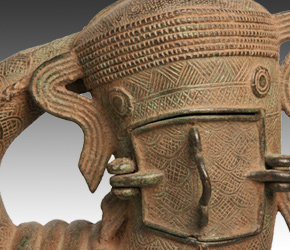 |
|
"Benin viewed the mudfish as a symbol of power, transformation, and royalty. The mudfish later became a royal symbol because of its unique ability to live in two worlds – having one foot on earth and one foot in divinity"
The ancient kingdom of Benin lies in the tropical rain forest of West Africa, next to present-day Nigeria. During its classical age, from the 14th to the 19th centuries, it produced one of the continent’s most glorious artistic legacies. To reflect the splendor of the royal court, the Oba (king) commissioned highly skilled artisans to create rare and beautiful works of art in materials such as ivory and bronze.
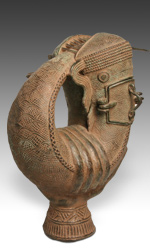 |
|
Typical of the artworks created for the royal court were human and animal figures, relief plaques, carved elephant tusks, pendants, bracelets, life size commemorative heads of Obas and queen mothers, and ceremonial objects to adorn the palace and the altars honoring Obas of the past. Many of these objects were intended as objects celebrating ancestors, as war trophies, and as focal points for sacrificial ceremonies. The most renowned examples of Benin “classical” art are the extraordinary sculptures cast in bronze. When Europeans first discovered this material in the 17th century, there was widespread disbelief that West African peoples could produce works of such high quality. The skills needed for metal casting were, however, well known in Africa from Senegal on the Atlantic coast to Northeast Nigeria dating as far back as the ninth century.
The production of bronze objects was almost always done using the “lost wax” method of casting. In lost wax methodology, a model (the statue) is carved from wax, or for hollow castings, from a thin layer of wax surrounding a clay core. A mold is then created to surround the wax statue. In turn, molten metal is poured into the mold and the wax is displaced. Finally, the mold is broken to reveal the statue. Using this method it is only possible to create a one-of-a-kind object since the mold and the wax original are destroyed as part of the production process.
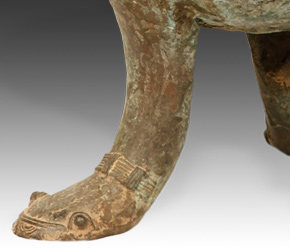 |
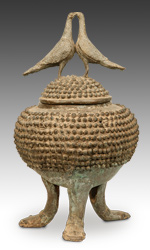 |
In general, the use of bronze objects was limited to individuals of the highest social class and fulfilled special ceremonial needs. It is impossible to say what the vessel depicting the mudfish held, but it is almost a certainty it was created for royal use because of what it depicts, a single hand holding the mudfish. Among their pantheon of sacred symbols, the Benin viewed the mudfish (Pylodictis Olivaris or flat-head catfish) as a symbol of power, transformation, and royalty. This was due to the mudfish's ability to lay dormant in mudflats all summer long, and then come back to life when rain came in the fall. The Benin saw this as being 'reborn' and it became a royal symbol because of this unique ability to live in two worlds. Benin royalty was also said to live in two worlds, having one foot on earth and one foot in divinity.
The mudfish also can emit a shock when disturbed, elevating its status as a symbol of power. It is interesting to note that when Portuguese explorers first came across the water on their boats in around 1485, the Benin saw them as powerful because they were able to 'live in the water as well as walk on land.’ This comparison to the mudfish, and in turn Benin royalty, gave the Portuguese instant status. The Portuguese also had muskets which the Benin equated to the shocking spines of the mudfish. These attributes of power and flexibility were the same attributes ascribed to the Benin Oba (king) as well-- a divine ruler who is part of both the human and spiritual realms.
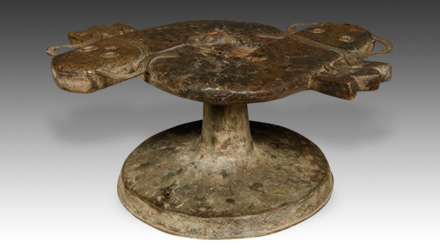
|
|
Download this Article: Benin Bronze Mudfish Vessel.pdf